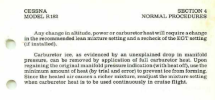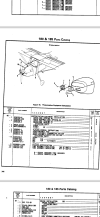This message in the carb ice thread jogged my memory about a question I had regarding carb heat on the cessna 172M I occasionally fly. I pull in carb heat whenever I'm below the green arc, as that's what the "owner's manual" tells me to do. Academically I understand this also makes the mixture richer, but I have no idea by how much.Remember that after you turn on the carb heat, you should lean the mixture, too.
I'm uncomfortable running the engine in this double rich condition, but that's what the poh says to do, right? Should I be leaning? The book doesn't mention it. I've had the thought that they might want the mixture extra rich and easy to light in case there is suddenly a bolus of water entering the cylinders as it melts out of the carb. What's the consensus among cessna flyers?


